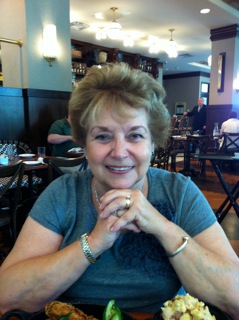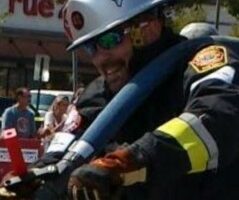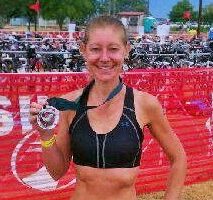This photo was taken before I went to the ER, but I was already having shortness of breath upon exertion. That was my only symptom. I saw so many doctors and had three CT scans without dye and nothing was found on my lungs.
One week in March 2015, my breathing got worse and one Sunday morning I was so weak that when I tried to roll over in bed, I fell onto the floor. I told my husband: Get me to the closest ER. We live in a retirement village in San Antonio. We have been here four years. It was 6:00 a.m. and I knew at this ER, being the second busiest in the city, that I would have to wait a long time to be seen, but that was not so. I was in a walker/wheel chair that someone had loaned to us. I was hanging over the side because I had no strength to sit up. The nurses ran to take me to the exam room and everyone was busy around me.
The doctor came in, asked a few questions and said, “I think you have a clot in your lung.” I said, “I’ve been tested for that, but they never found anything.” Luckily, he did not listen to me, and I had another CT scan with a newer, more powerful dye and the clot was found immediately.
I was in the hospital one week and came home with warfarin, oxygen 24/7, and a wheelchair. I was mentally and physically unable to care for myself. The hospital fell down on the job. I should have been sent to rehab, but it was the weekend and the doctor sent me home.
So, this is what I want to tell everyone, no matter what your age may be:
- Go to the ER if you have shortness of breath. I did not. I tried to tough it out at home. The ER has all the equipment that your family doctor doesn’t have.
- As far as going to rehab, once you are at home, you cannot go to rehab, according to Medicare. You must go from the hospital right into rehab.
- I got home healthcare and a licensed practical nurse or LPN came once a week to check my INR. A registered nurse or RN came once a month to check on me. Physical therapy came twice a week to get me started walking again. It was a long and tough road, and home healthcare is fine, if you have a great caretaker and that is what my husband did for me. I could not shower or dress myself or make any food. He did it all. So, you will need someone 24/7 if you are as bad off as I was.
- Mentally it’s a shock to your brain and to your system to be so sick. I had anxiety attacks, especially when I awoke in the mornings. A common anti-anxiety medication worked for me. Also, I had printed out 100 comments from another blog about blood clots and I would read and re-read them when I was feeling down.
- I stayed in the house for six months. It wasn’t as bad as it sounds. I was too ill to even care about what I was missing in the real world. The weakness was the worst, and my iPad became my best friend.
- After six months of warfarin, my clot is gone but I am still in recovery to regain stamina. To build up strength, I go to the pool three times a week and swim. Walking is the best exercise, but with a bad hip and foot, it isn’t easy for me. I am now able to walk to the pool and back home without oxygen.
- No known reason was given to me for the blood clot. I do not have an inherited gene, so where it came from is a puzzle. I am worried I will have another one. The only thing I do now to avoid one is to take an aspirin each day. The hematologist also told me to buy an oximeter and check my oxygen levels every day, which I do. If it is 88 or below for a few days, I am to go to the ER because it might be another clot.
- There are side effects with warfarin for some people. For me, my hair broke off and thinned out, my skin sloughed off, and I had nausea and diarrhea, but it did the job as an anticoagulant.
If someone reads this and it helps them, I will be glad. If it weren’t for a very patient husband and his care, I would have been in the nursing home for all those months. I don’t know how people handle this disease when you have jobs and families and need to make a living. One doctor told me this when I was younger, “FIRST you get healthy, and then you worry about your job.” Easier said than done. I survived, but it was a long hard process and I had a lot of help as this year went by.
To learn more about blood clot signs and symptoms, click here.



